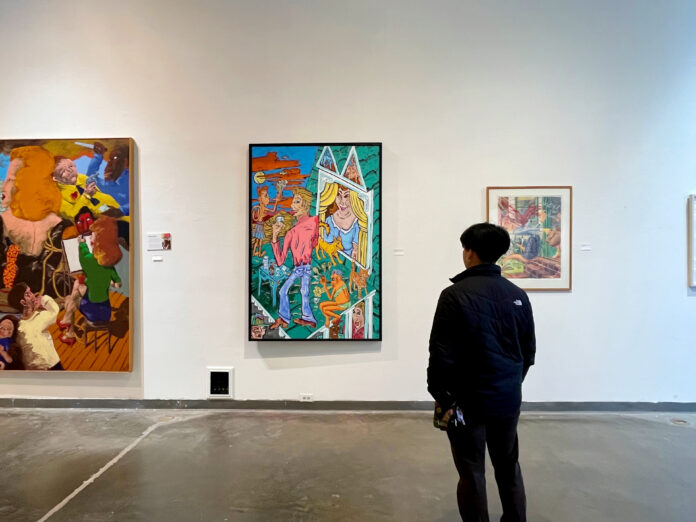The John Natsoulas Gallery celebrates the work of UC Davis Emeritus Art Professor Robert Arneson with 30-year Memorial Exhibition
By MARIA MARTINEZ CASTRO — features@theaggie.org
On the second floor of the John Natsoulas Center for the Arts, the work of famous artist and UC Davis Emeritus Art Professor Robert Arneson sits waiting for the Davis community to see. Walking through the space and stepping on the creaky wooden floors of the gallery, the art forms Arneson was most famous for — ceramics and self-portraits — are on display.
At the top second-floor stairs, you are greeted with a cheeky self-portrait of the artist, who is staring at you picking his nose in an explosion of color. Further into the room are ceramic forms of foods, bricks and portraits of Cold War United States and USSR army generals.
The Robert Arneson 30-Year Memorial Exhibition will run from Nov. 2, 2022, to Jan. 7, 2023, at the John Natsoulas Center for the Arts in downtown Davis. The exhibit honors the late artist’s work and his contributions to the UC Davis Department of Art.
Arneson is most well-known for his ceramics and self-portrait work, his massive influence on the Funk art movement, and his establishment of the famous ceramics art studio TB-9 (Temporary Building 9) at UC Davis.
“He revolutionized sculpture and he created, there’s a movement on the first floor, called Funk art,” John Natsoulas said, founder and operator of the John Natsoulas Center, and Arneson’s mentee. “He was the clay godfather of Funk art. There are painters in there; there are sculptors in there, but he was it.”
Arneson’s career at UC Davis spanned three decades, from 1962 to his retirement in 1991. While at the university, Arneson and his students changed the trajectory of ceramics as an art form. They did so in the margins at the famously known TB-9 studio on campus.
“Temporary Building 9, which was the ceramics building, you know how that started?” Natsoulas said. “That’s where food science had all of their fruit. A lot of their fruit and vegetables were canned and jarred and stored there. It was a giant fruit and vegetable storage, and these guys and gals ate it all for them to have room to have this big ceramics warehouse.”
Simon Sadler, chair of the UC Davis Design Department and professor of design, spoke to the revolutionary nature of Arneson’s ceramics works.
“It is a bit of a marginal art form,” Sadler said. “But UC Davis is a bit of a legend in ceramics. Arneson was famous for creating a culture around TB-9 […] Arneson was a bit on the margins as a ceramicist, in a department that was on the margins […] in the 1960s and ‘70s.”
Natsoulas also pointed out the importance of Arneson’s influence on ceramics at UC Davis, and specifically his use of the TB-9 building.
“The impact of TB-9 at that time was huge,” Natsoulas said. “Now, there are no ceramics sculptors working in the graduate [department]; there is not really that kind of movement because he was so amazing.”
However, Arneson’s legacy at UC Davis extends beyond the ceramics Funk art movement and TB-9. Students on campus can witness his work every day when walking by the Shields Library, Mrak Hall or the UC Davis School of Law.
Arneson is the creator of the famous Egghead sculptures on campus, which Sadler believes Arneson created as light-hearted critiques of the university.
“They are kind of endearing, but they are critiques,” Sadler said. “An egghead, you know, is a euphemism for an intellectual. […] Arneson was probably like […] at once sort of happy and grateful to be at the university and on the other hand thinking, ‘What the hell am I doing at the university? Why am I with all these other eggheads who think that everything’s gotta be scientific and provable when clearly I’m a counterculturalist, full of emotions and fun-loving?’”
The Eggheads and the exhibition at the John Natsoulas Gallery showcase the intricate work and mind of an important artist and professor in UC Davis history.
“The big legacy is of art at UC Davis,” Sadler said. “And it’s been sort of a hidden legacy for a long time. Arneson was famous […] but we’ve never quite known what to do with that legacy, and I think [what] the creation of the Manetti Shrem Museum does is [help] solidify UC Davis, not just as one of the world’s preeminent centers of agriculture and animal science, but it’s also a weird place where you can go study the arts out in the tomato fields. And there’s a long legacy there.”
Written by: Maria Martinez Castro — features@theaggie.org





